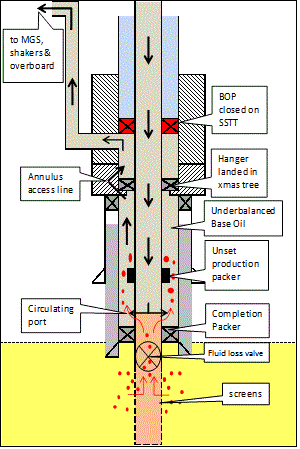
Barrier verification missed: Open fluid loss valve leads to well control incident
The incident occurred during the final stages of the completion of a horizontal screen producing well.
The installation of lower completion was completed and the liner top packer was successfully set and pressure tested.
The remaining program steps were to place a base oil cushion above the closed fluid loss valve to create an under-balanced condition to support production kick off.
The path for the brine to base oil displacement was from the cement unit, down the tubing string, through a ported sub installed above the completion packer and then up the annulus. Brine returns were discharged overboard until a dyed interface was observed. The intention was to displace the entire well (tubing and annulus volume) above the fluid loss valve to base oil (+/-125m³).
The well displacement to base oil commenced once the tubing hanger was landed, latched, and over-pulled. When displacement was complete, flow was observed to continue from the well. The Driller shut-in at the surface choke and monitored the wellbore pressures on the tubing and annulus. It was estimated that an influx of 23m³ had entered the well.
The influx was bullheaded back into the formation by pumping base oil from the cement unit.
What Went Wrong?:
- Fluid Loss Valve failed unexpectedly to the open position. The cause of the valve opening could not be determined (i.e. failed open or opened unintentionally).
- Brine returns were being discharged overboard and were not being accounted for.
- No in-flow (negative pressure) test was incorporated into the displacement to hold constant bottom hole pressure until the displacement was complete.
- A previous in-flow test to a seawater gradient was believed to be sufficient to qualify the barrier, but this test did not expose the well barrier to the maximum pressure differential that would have been experienced at the completion of the displacement to base oil.
- A loss of situational awareness by the Driller contributed to by various cognitive biases allowed the influx to continue while indicators were present.
- There was an inadequate focus of process safety (major accident hazards) in favour of occupation/environmental hazards associated with the task.
Root Causes:
- Lack of well control procedures implementation
- Well integrity requirements not implemented in Operator well planning process.
Figure 1

Corrective Actions and Recommendations:
- Improve well planning process to include more detailed assurance checks for key well integrity requirements and improved stakeholder review.
- Improve understanding and use of major accident hazard risk assessment (Bow Tie diagrams) in the verification activities to control major accident hazards conducted by rig site supervisors.
- Incorporate specific requirements to demonstrate management system requirements into the competency assurance program.
- Improve well control auditing to obtain objective evidence of policy implementation.
- Increase awareness of the effects of cognitive bias in process safety and ways to increase sensitivity to "weak signals" in well control.
safety alert number: 274
IOGP Well Control Incident Lesson Sharing http://safetyzone.iogp.org/
Disclaimer
Whilst every effort has been made to ensure the accuracy of the information contained in this publication, neither the IOGP nor any of its members past present or future warrants its accuracy or will, regardless of its or their negligence, assume liability for any foreseeable or unforeseeable use made thereof, which liability is hereby excluded. Consequently, such use is at the recipient's own risk on the basis that any use by the recipient constitutes agreement to the terms of this disclaimer. The recipient is obliged to inform any subsequent recipient of such terms.
This document may provide guidance supplemental to the requirements of local legislation. Nothing herein, however, is intended to replace, amend, supersede or otherwise depart from such requirements. In the event of any conflict or contradiction between the provisions of this document and local legislation, applicable laws shall prevail.
